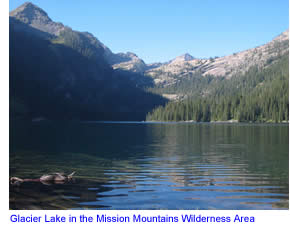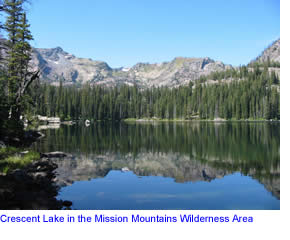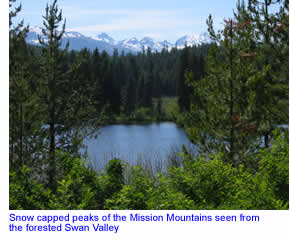
The Mountains of Montana
The Mission Mountains

 |
The Mountains of Montana
|
 |
| You are Here > Home > Mountain Fishing > The Mission Mountains | Search Site |
The Mountains in Montana |
The Mission Mountains
|
 |
| Photo Use Guidelines |
The Mission Mountains are located in the Northwest part of Montana, south and east of Flathead Lake, more or less mid-way between Kalispell and Missoula. The Mission Mountains are hard to miss when seen from the west in the lower Flathead Valley - the mountains have a vertical rise of over 6000 feet from the valley floor below with no foothills. The mountains themselves run for over 40 miles north to south, have numerous alpine lakes, several glaciers and many year round snow fields.
The Mission Mountains are unique among American wilderness areas in that two different wilderness areas protect much of the Mission Mountains. On the eastern side of the Mission Mountains, which includes the Swan Valley, the federally designated Mission Mountains Wilderness Area protects more than 70,000 acres of stunning mountain countryside.
 |
| Photo Use Guidelines |
On the western side of the Mission Mountains, which faces the lower Flathead Valley, much of the land lies within the Flathead Indian Reservation. To protect this area from development, the tribe created a tribal wilderness that protects more than 89,000 acres of pristine mountain scenery. Due to this "dual ownership" of the Mission Mountains, it is necessary for hikers to be aware of where they are starting. Accessing the Mission Mountains from the Flathead Indian Reservation requires a permit. In addition, parts of the tribal wilderness are closed to all uses during certain times of the year to protect critical grizzly bear habitat.
The Mission Mountains, despite their size, have only limited on-trail hiking opportunities. Unlike many other wilderness areas of similar size, only 45 miles of hiking trails are found in the Mission Mountains Wilderness Area, with a scattering of other trails on the tribal wilderness section and in the adjacent national forest lands. This, combined with the areas close proximity to the Bob Marshall Wilderness Area and Glacier National Park, helps keep use down in the Mission Mountains.
Numerous high alpine lakes are scattered about throughout the Mission Mountains, most of which lie either in the tribal or federally designated sections. Many of these lakes have good fishing for cutthroat trout. However, these lakes have recently begun to see a lot more use. To protect the fragile habitat around many of the lakes, camping is prohibited around several of the popular lakes, including Turquoise Lake and Glacier Lake.
 |
| Photo Use Guidelines |
Overnight camping is not as popular in the Mission Mountains as is found elsewhere. This is due to both the camping restrictions on several of the more popular lakes as well as because long, loop backpacks using trails is not possible since the trails in the Mission Mountains do not inter-connect with one another. Additionally, the Mission Mountains rise very steeply and are very rocky, limiting the amount of campsites available.
Wildlife is very abundant in the Mission Mountains, including Grizzly Bears. As such, it is necessary to take the normal precautions when visiting this area, such as not cooking where you will be camping, making noise on the trail if possible and storing all food well away from campsites. See our special section about Hiking in Grizzly Bear Country for more information about bears and hiking.
| Montana Web Cams | Montana Information | Fly Fishing Gear | Fishing Boats | Internet Home Business | Site Map | About | Contact Us | Advertising Information | Privacy Policy |